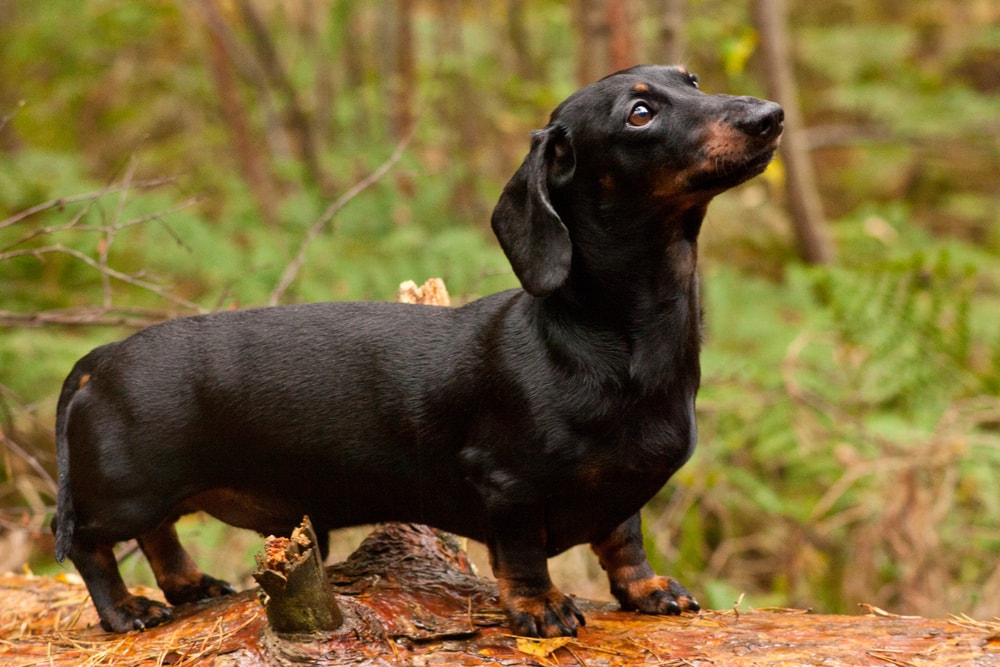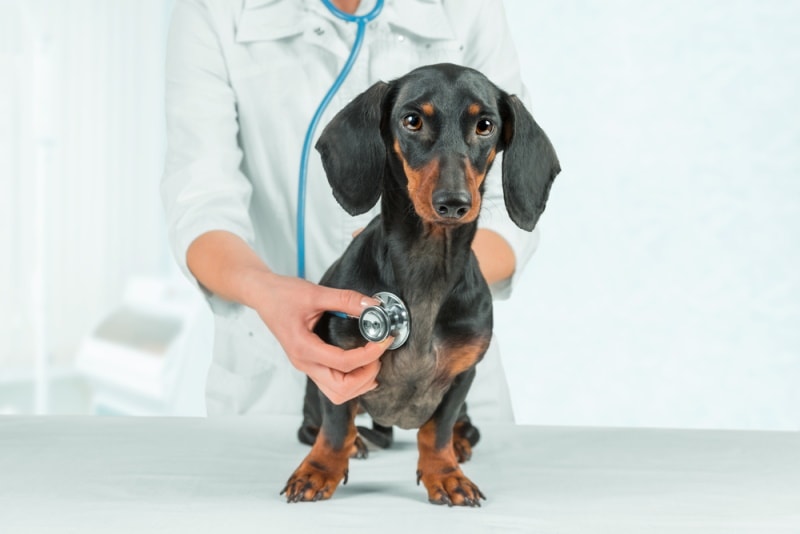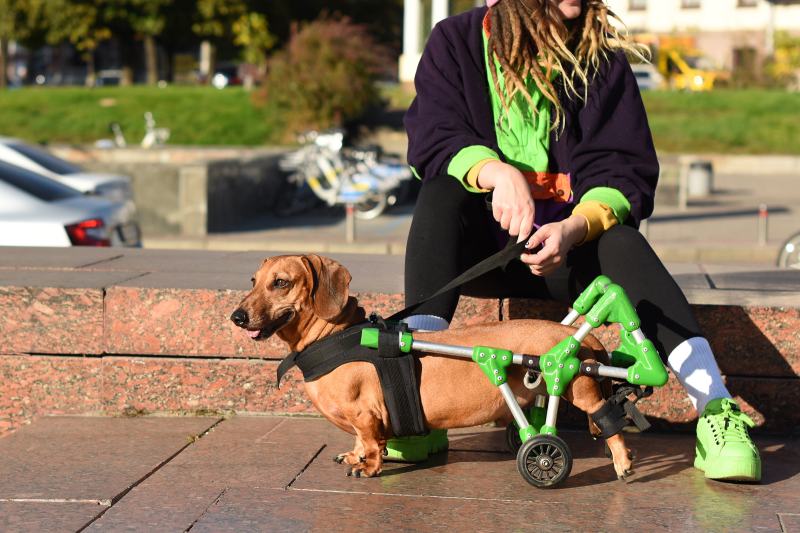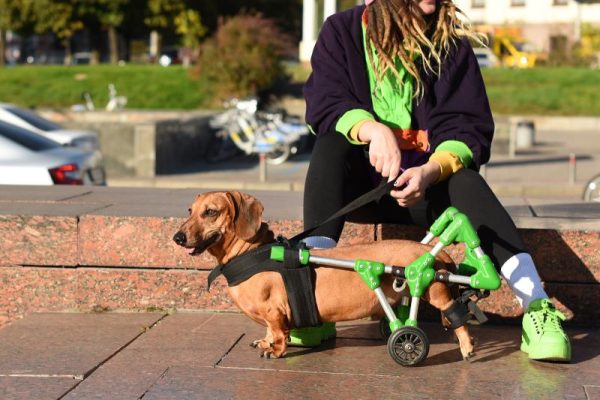You’ve probably come into contact with many Dachshunds in your life because they’re such popular pets. You may even own one yourself. These little dogs have long faces, short legs, soft ears, hard coats, and long backs. They’re fearless and aren’t afraid to show aggression toward other animals that are much larger than themselves. These dogs are strong at heart but have struggles of their own as they are prone to IVDD, which affects their long backs.
IVDD can occur in large, medium, and small breeds, but it’s usually a slow progression that starts later in their lives. However, in Dachshunds, it begins much earlier. To best prepare for a life with a Dachshund, it’s important to understand IVDD and how it’s caused, what the signs are, and how you can best care for your dog. Let’s discuss this disease further.

What Is IVDD?
IVDD is the acronym for Intervertebral Disc Disease.1 This disease can affect any dog, but it is much more common in Dachshunds and other breeds with long backs and short legs. As your dog grooms itself, plays, jumps, or runs, the spine bends to give your dog the flexibility and movement to do each activity.
Your dog’s spine is made up of vertebrae, which are small bones that protect the spinal cord. They run from below your Dachshund’s skull to their tail. Between each individual vertebra is an intervertebral disc, which acts as a cushion to prevent the vertebrae from grinding against each other. It also absorbs the impact running, jumping, and other activities can place on your dog’s spine.
Unfortunately, a Dachshund with IVDD will experience inflammation and pain because the disease causes the disc to deteriorate to the point of tearing, rupturing, or bulging. This can lead to it pressing against the spinal cord, which can cause damage to it. Symptoms may look slightly different depending on where in the spine the ruptured disc is, but that problem disc will no longer be able to perform the function it had before of absorbing pressure.

What Are the Signs of IVDD?
If you have a Dachshund or any dog with short legs and a long back, you should consciously look out for signs of IVDD because if this disease isn’t addressed early on, your dog will constantly be in pain and may end up with permanent damage, such as paralysis. Dogs that have experienced trauma to their backs can also have a type of IVDD.
- Pain in their back
- Whimpering or crying when picked up or doing certain activities
- Unmotivated to play
- Stiffness
- Shivering
- Breaking potty training
- Walking differently or arching their back
- Unable to walk
- Weakness
- Paralysis
Your dog may display different signs depending on where the problematic intervertebral disc is. The deterioration of the disk or disks usually happens gradually, and the dog will show signs of pain by becoming inactive. Owners often miss the initial signs as they aren’t dramatic or alarming. However, it can happen suddenly,2 too, with a seemingly healthy, active Dachshund becoming paralyzed within the same day.

What Are the Causes of IVDD?
IVDD is very common amongst Dachshunds. Many people want to know what causes this disease in this breed in an effort to prevent it and ensure their dog has the best quality of life. However, IVDD isn’t caused by one specific thing, and there is more than one type. Sadly, this disease can affect any dog, regardless of breed or age.

Type 1
Type 1 is the type of IVDD most commonly seen in Dachshunds. Its cause has a bit to do with genetics, but not entirely, as other dog breeds can also suffer from this type. However, it mostly affects dogs with short legs and long backs, and pain and damage can occur suddenly.
Type 1 is identified as the hardening or calcification of the center of the gel-like cushion, known as the intervertebral disc. If force impacts that hardened disc by jumping down from a surface that is too high, for example, that disc can suddenly dislodge and push into the spinal cord and ligaments. This will cause inflammation and some level of damage and leave your dog in pain.
Type 2
Type 2 is often caused by trauma and injury. A pup that has been hit by a car, had something heavy fall on their spine, or has fallen from a height often develops type 2. The degeneration and collapse of the intervertebral disc are much slower in this case and can take years to show signs of serious damage. Instead of a sudden dislodge and push into the spinal cord, as in type 1, the outer part of the intervertebral disc bulges and pushes onto the spinal cord and nerves slowly in type 2.


How Do I Care for a Dachshund With IVDD?
As soon as you notice any of the signs of IVDD that we’ve listed above, it’s imperative that you take action. Pain without any other serious symptoms can result in a trip to your vet for an examination, but if your dog is showing signs of not being able to walk, you should take them to the emergency clinic. The faster your Dachshund can receive the appropriate care, the better their chances will be at recovery.
Your vet will likely do a physical exam of your dog upon arrival, and then they may want x-rays of the spine and request an MRI or CT scan. Depending on how severe the damage is or where it’s located, your dog may receive medication and forced rest or require surgery.
Medication and Rest
The medication and rest are necessary to ease the inflammation and relax the muscles. It’s recommended that your dog stays at the hospital in their cage until their compulsory rest period is over to ensure they are adequately confined and cared for.
However, your dog will need to be confined to their cage for at least three weeks. If you cannot afford to keep them at the hospital or the vet is happy for you to care for them at home, you will need to give them their medication throughout the day, apply an ice pack to their spine, and confine them in a pen or cage at home. Your dog may cry to be released from the cage but allowing them freedom will stop their healing and cause further damage. You will need to carry them or slowly walk them outside to pee and poop, but they must be returned to their cage straight after.

Surgery
In more serious situations, surgery is necessary to take the pressure off your dog’s spinal cord. It could allow them to walk once again and have relief from the pain, but this isn’t guaranteed. Due to the risk and cost of surgery, it typically isn’t offered unless your dog cannot walk, has been paralyzed for only a few days, or cannot get pain relief any other way.
Your dog will need to stay in the hospital after the surgery until it regains its bladder and bowel control. You will be encouraged to visit your dog at the hospital to encourage them to walk, but physical therapy is usually necessary after surgery.
Once your Dachshund is back home, you need to stop them from being able to jump up onto your furniture or climb the stairs. Protecting their spine from further impact is essential. Feeding your dog the portion sizes your vet recommends to keep them at a healthy weight is also a part of how to care for Dachshunds with IVDD.

Frequently Asked Questions
Can a Dachshund need more than one IVDD surgery?
Unfortunately, a Dachshund isn’t out of danger after surgery, as a slipped disc can occur in another area of the spine. However, they may not require surgery once again, and strict cage rest and medication may be recommended.
Can this disease be prevented?
You cannot prevent IVDD in your Dachshund, but you can decrease their risk by keeping their weight under control through exercise and correctly portioned meals according to their life stage. Train your Dachshund to walk next to you off their lead to reduce pressure on their neck and spine, and use a harness instead of a lead when required. To prevent high-impact activities and the risk of falling, train your Dachshund not to jump up onto your bed or furniture and install ramps instead.

Conclusion
IVDD is a disease that commonly affects Dachshunds and other breeds with short legs and long backs. However, it isn’t unique to these breeds and can affect larger dog breeds too. There are two types of IVDD, with one causing sudden pain and damage and the other causing problems over a longer period.
Depending on the severity of the pain and damage, your Dachshund may require strict cage rest and medication or surgery. Unfortunately, even surgery doesn’t guarantee another slipped disc in the future but reducing high-impact activity is a way to lower your dog’s risk.
Featured Image Credit: TetiBond, Shutterstock









